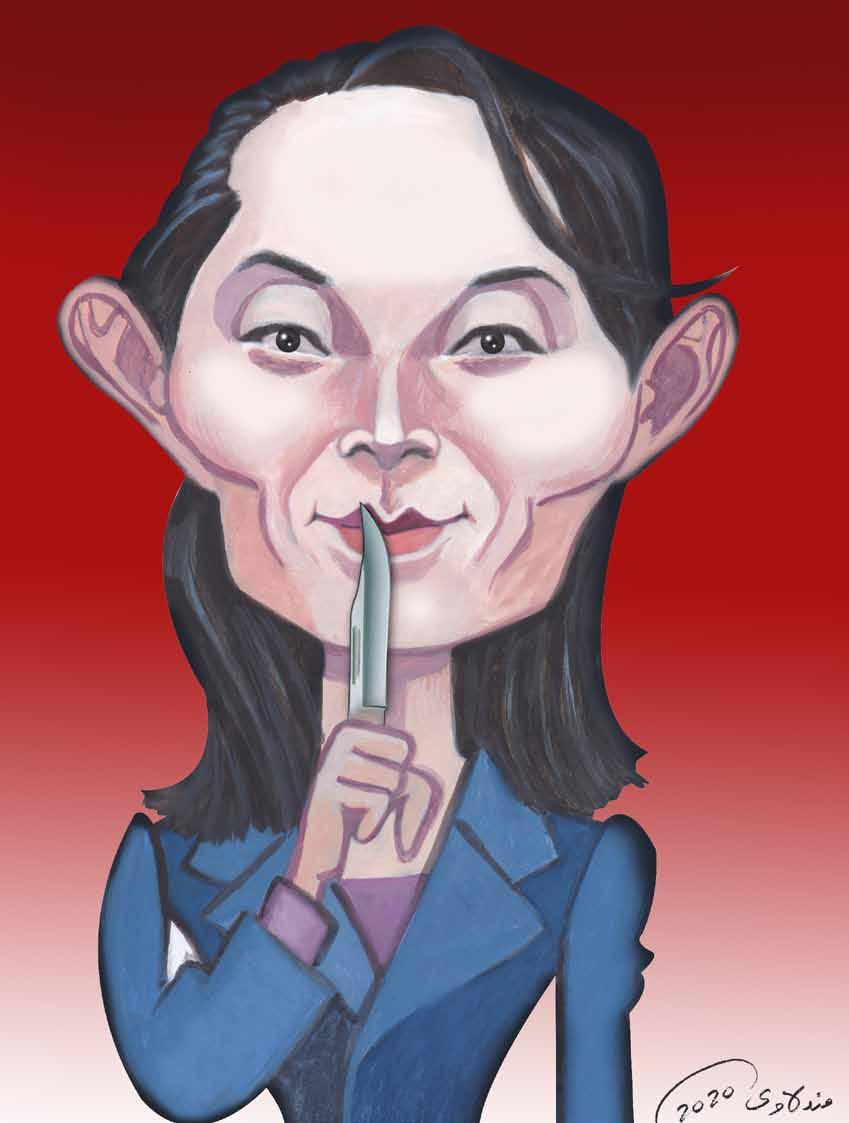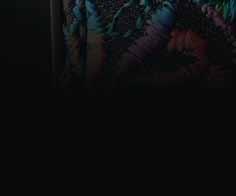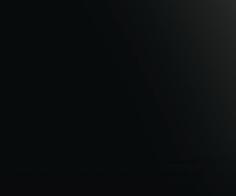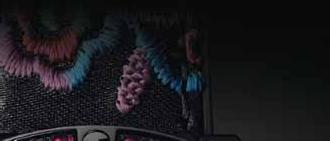
23 minute read
How Indigenous Zombie Horror Film ‘Blood Quantum’ Became Prescient in the Pandemic
by المجلة
ulture C
How Indigenous Zombie Horror Film ‘Blood Quantum’ Became Prescient in the Pandemic How a Horror Film Took New Meaning Amid Coronavirus
Director of ‹Blood Quantum,› Jeff Barnaby. (Johnny Wong/ Elevation Pictures/TNS)
by Jen Yamato
Jeff Barnaby never thought he’d be releasing his zombie outbreak movie “Blood Quantum” during an actual global pandemic, or that the real-life parallels within a film bursting with blood, guts, a samurai-sword-wielding grandpa and severed body parts would make his groundbreaking horror tale all the more eerily resonant.
“Now that we’re in the middle of this virus it’s brought a lot of the ideas in the film into relief and stark contrast,” said Barnaby, Skyping from his home in Quebec. His second feature, now streaming on Shudder, imagines a world in which those with indigenous blood are immune to a vicious zombie apocalypse. Set in 1981 and shot in Canada on Mohawk and Mi’gmaq land, “Blood Quantum” unfolds on the fictional Red Crow Reserve where Traylor (Michael Greyeyes), a troubled-but-trying local sheriff, struggles to lead his community as outsiders seek refuge from the rising undead. The title puts a biting twist on the controversial U.S. government policy of measuring indigenous identity based on percentage of ancestry. But with the coronavirus now tearing across the world — heightening anxieties, escalating xenophobia, underscoring systemic inequities and disproportionately devastating the Navajo Nation — the unexpected refractions of our current reality are making Barnaby’s head spin. “The weird thing about being native and making a comment on viruses in particular is the history of the pandemics and the colonization of America,” said Barnaby. “Once you put a native person in a zombie film, you immediately start thinking that it’s a virus. It’s one of the benefits of being a native film director: You have so much history to riff on. It exists in history and in our society and in the history of our cinema and literature.” He paused, lingering on the thought. “It’s so much to unpack. It’s a lot to take on, being a native filmmaker, man.” Barnaby set his 2013 debut drama “Rhymes For Young Ghouls” against the backdrop of Canada’s residential schools, institutions of assimilation for which the government has since apologized. Influenced by writers like Stephen King and Clive Barker, in his short films and features he’s leaned into sci-fi and horror genres, blending his pulpy directorial flair with a lens on history that’s long been absent from stories involving indigenous people. Playing in fictitious alternate realities creates some distance from the presumption that he’s speaking for the indigenous community. At least, he thought it did. When “Blood Quantum” premiered at the Toronto International Film Festival, the metaphors helped its raucous horror thrills land with the weight of history. Now, it’s hard to keep current events from creeping in while watching Barnaby’s accidentally prescient tale. “What I’ve always tried to do is infuse my work with the idea that you’re looking at fiction. At no one point are you going to be able to say these native people exist, because the world they exist in isn’t real. There’s no such thing as zombies. There’s no apocalypse,” said Barnaby. “Of course, saying that now seems kind of trite.” With a wicked sense of humor and sharp sociopolitical undertones, “Blood Quantum” features a cast of First Nations and Native American actors led by Greyeyes (“True Detective,” “Fear the Walking Dead”), Elle-Maija Tailfeathers (“The Body Remembers When The World Broke Open”), Forrest Goodluck (“The Revenant,” “The Miseducation of Cameron Post”) and Kiowa Gordon (“The Twilight Saga,” “Roswell, New Mexico”). Ravenous hordes descend, chainsaws swing, heads are liberated from their reanimated corpses and Barnaby winks gleefully more than once at Quentin Tarantino’s “Pulp Fiction.” In one scene, Waylon Jennings roars on the -8track as a hero goes head-to-head with flesh-eating zombies; in another, a character receives a painful surprise during oral sex when his infected partner turns at an inopportune moment (a commentary on postcolonial misogyny and toxic masculinity, the filmmaker says amusedly). As the apocalypse unfolds, old wounds fester and conflicting views on self-preservation put the group’s survival into jeopardy. Half-brothers Lysol (Gordon) and Joseph (Goodluck) bond over their strained relationships with their dad, Traylor; Joseph, who has a baby on the way with his white girlfriend, Charlie (Olivia Scriven), wrestles with fearful unknowns; his mother Joss (Tailfeather), Traylor’s ex and a trained nurse, quietly springs into action when the reservation seals itself from the outside world, then comes under siege. Veteran actor Greyeyes, whose stage and screen career has often explored indigenous experiences but rarely with an indigenous filmmaker at the helm, loved the premise from the start. “It’s not just a film, it’s a political action to flip the switch and go, ‘The land that we deemed worthless, the rez that we stuck
ulture C
you on? That is now the safest place in the world. Whereas we pushed you away from the heart of our communities, now we’re seeking entrance into yours,’” he said. “This idea that colonial history has been reenacted subversively is a message that even the most nonpolitical, non-socially informed person will understand right away.” “Blood Quantum” blends the zombie movie DNA of George A. Romero’s “Night of the Living Dead” with the sociopolitical lineage of the 1984 Alanis Obomsawin documentary “Incident at Restigouche,” which chronicled raids by Quebec police upon the Listuguj Mi’gmaq First Nation over salmon fishing rights in 1981, the year “Blood Quantum” takes place.
In an opening nod to Obomsawin’s film and the community’s history, a gutted pile of fish are the first to rise from the dead. Traylor’s WWII vet father Gisigu (Stonehorse Lone Goeman, a sword-wielding standout making his acting debut) eyes his haul with disbelief as they flop back to life, then steely resignation sets in. Zombies? Fine. He’s seen and survived plenty before, the movie suggests. What’s an undead outbreak to someone who’s made it through so much already?
Barnaby grew up in Listuguj at the time of the raids and always envisioned his hometown as the setting of “Blood Quantum.” Before making the film in Listuguj and on the Kahnawake reserve near Montreal, he asked his actors to watch “Restigouche” so they’d understand the community’s history and its hard-won traditions. For many of the cast members, “Blood Quantum” marks a leap forward in screen representation.
Devery Jacobs made her starring debut as the teen heroine of
Barnaby’s “Rhymes for Young Ghouls,” also set in the fictional Red Crow community and filmed on the Kahnawake reserve where she grew up. In “Blood Quantum” she plays James, a hardened version of the woman her headstrong “Rhymes” character might have become “if she had turned to the dark side.”

“I wouldn’t have a career today if it wasn’t for Jeff and for that project,” said Jacobs, whose recent credits include Netflix series “The Order” and Starz’s “American Gods.” “‘Rhymes’ was my first leading role and also the first role I could really sink my teeth into, and the first project that really reflected my experience and that of my family’s.”
It wasn’t easy getting “Blood Quantum,” a rare film to feature the Mi’gmaq language and characters, to the screen. Working with his “Rhymes” cinematographer Michel St-Martin, Barnaby served as writer, director, editor and composer. There were tough days filming on location in the elements; limited resources; over-the-top stunts.
On top of the typical indie film constraints, Goodluck felt the added pressure of having to film a heavy emotional moment during a zombie outbreak while standing in a small boat against a thicket of fog with a team of FX pros circling, faux blood at the ready. “They were trying to create this crazy Kurosawa-type
Teaser poster art for ‹Blood Quantum.› (Elevation Pictures/ TNS)
A scene from ‹Blood Quantum.› (Jan Thijs/ Elevation Pictures/ TNS)
atmosphere,” said Goodluck. “It was scary because I was like, if I don’t get this during this take, I know we’re not going to get another one!”

Production even went on hiatus for several months while the weather changed and Barnaby banged on doors to secure funds to finish the film. But at least he found receptive backers. When he’d first pitched the project in 2007, he said, no one would bite. on the other hand, bears the scars of his fractured upbringing. “He doesn’t know how to reconcile,” said Gordon. “The only way he knows how is through violence, what he grew up with.”
“It was a different time. Nobody was ready for a story like this,” he said. “Nobody was ready to hear that the great capitalist dream was falling apart and colonialism was going to help usher us into destruction. So it was the culture that took catching up to the script. Nothing changed, just the cultural perception of it.” The timing feels apt to Goodluck and Gordon, whose characters represent challenges facing youth stepping into a world not of their making. “It’s especially relevant today with every aspect of global destruction that young people are inheriting, from not just the native communities but everywhere older generations have messed up the planet, possibly to the point of nonreversal,” said Goodluck. His character manages to hold on to hope. Gordon’s Lysol, “It’s been a struggle my entire life, being who I am and trying to find out who I am,” he said. “I’m on the cusp of even being in my tribe because of the blood quantum. My daughter isn’t registered into my tribe because of that, because she only has a particular quantum in her. How does somebody else get to define who we are? It messes you up in the head.” “In this industry, ever since natives were in cinema, it’s always been somebody else’s voice, and somebody else’s face, and somebody else’s makeup on them. Now we can actually take that back, and this film is iconic for that,” he said. “(‘Blood Quantum’) is ushering in a new age for the next generation to say, ‘OK, let’s go out there and take our lives back.’ I feel empowered through this.”
Gordon, who is of Hualapai descent and was raised partly on his tribe’s reservation in Arizona, found that the film’s themes, and its provocative title, resonated with elements of his own ongoing journey.
ealth H
Give Yourself a Lift

A Simple Exercise Called the Deadlift Helps Make Everyday Actions Easier and Safer
by Harvard Men’s Health Watch
Research shows that weight lifting is good medicine for healthy older adults. While there are many weight-lifting exercises, one move you should always include with your workouts is the deadlift. position, you grab a weighted barbell and then stand while you lift the bar with straight arms. The barbell rises to about mid-thigh level. You hold for a second and return to the starting position.
It’s a short, quick movement, but much happens during that time, says Shawn Pedicini, a physical therapist with Harvardaffiliated Spaulding Rehabilitation Network. “Deadlifts give
The deadlift is a simple-looking movement. From a squatting position, you grab a weighted barbell and then stand while you lift the bar with straight arms. The barbell rises to about mid-thigh level. You hold for a second and return to the starting position.
you a lot of bang for your buck.”

MULTIPLE MUSCLES
This highly functional exercise carries over to many everyday movements. For instance, deadlifts can increase lower-body strength and power, which improves mobility, balance, and stability. Deadlifts are also great for working your hamstrings and core, particularly the gluteal muscles in the buttocks.
“These muscles help you to pick up things, lift and carry items, and protect your body from strains and injury,” says Pedicini.
Worried about poor posture? Deadlifts strengthen a weak lower back that can cause stooped shoulders. They also can improve grip strength, and some research has suggested that performing compound movements like deadlifts may increase bone density.
Enlist a personal trainer or fitness coach to show you how to perform a deadlift properly. “If you don’t do it correctly, there is a risk that you could put too much stress on your lower back,” says Pedicini.
If you don’t have access to a barbell, holding a dumbbell or a kettlebell in each hand also works. Another option, if available, is a trap bar, also known as a hex bar. The trap bar is shaped like hexagon or diamond. You stand in the middle and lift the bar using two handles that are placed shoulder-width apart. “The design distributes the weight more equally and takes further stress off the lower back,” says Pedicini.
You don’t need to do many deadlifts to feel the results. A typical approach is three sets of five to eight reps with a break in between, says Pedicini. “A higher number of reps can cause your form to break down and lead you to round your back.”
However, a personal trainer or physical therapist can advise you on the ideal number of sets and reps based on your fitness level. A beginning safe weight would be 40% to 50% of your body weight. Then gradually increase the amount if you can complete a full set of eight repetitions with proper form.
ealth H

CHECK YOUR MOBILITY
You need some mobility in your hips and ankles to do deadlifts correctly. Otherwise, you risk putting undue stress on your lower back. A quick test is to see how close you can come to touching your toes with straight legs. If you have trouble, then it would be wise to first work on flexibility of your back muscles before attempting deadlifts. Also, check with your doctor if you have any health problems for which you need to avoid excessive straining.
THREE PHASES OF LIFTING
The deadlift consists of three phases: the starting position,
upward movement, and downward movement. Starting position. Begin with the barbell on the floor. Stand with your feet slightly wider than shoulder-width apart, with your toes under the bar. Squat down, keeping your chest up to help maintain a neutral spine position. Make sure you don’t round your back and that you squat and not just bending over. Grasp the bar with an overhand grip, with your arms just outside your thighs. Pull your shoulders down and back, so your chest sticks out. Brace your core to help stabilize and protect your spine during the movement.
Upward movement. With your core engaged, push through your heels to begin the lift. Engage your back and abdominal muscles, and keep your shoulders pulled back to avoid rounding the shoulders. Stand and pull the bar up with straight arms, keeping the bar close to your body as it moves upward. The bar should rise to about mid-thigh level and should always stay in contact with your legs and not lift away.
Downward movement. Hold the lift briefly, then slowly lower the bar toward the ground while maintaining a straight back. Bend your knees so the bar and your hips lower at the same speed. Finish with the bar on the floor, so the weight comes to a dead stop. You should end in the original starting position. This completes one rep. You can immediately go into another rep, or reset your position from the beginning.

Po rt

ra it
Kim Yo-jong: North Korea›s Most Powerful Woman and Dictator in Waiting
Majalla – London Born in September 1987, Kim Yo-jong is the youngest daughter of late leader Kim Jong-il and is thought to be the most important figure in the tyrannical regime after Kim Jong-un. She is the only one of his siblings considered a close, trusted and powerful ally and is seen by his side almost constantly during his meetings with world leaders Kim shares the same mother as Kim Jongun and Kim Jong-chol, the brother who is thought to be not very senior in the political power system. She spent her early years at her mother›s Ch’angkwang Hill residence in central Pyongyang with her two older brothers. Between 1996 and 2000, Kim studied in Switzerland. She began attending Liebefeld Hessgut public school and later was joined by Kim Jong-un at Liebefeld-Steinhölzli public school, the two enrolled under pseudonyms. School officials in Switzerland have said she was over-protected by the coterie of guards and caretakers - she once reportedly had a mild cold and was immediately pulled from school and taken to hospital. Although they lived with an aunt and uncle, the time abroad was said to be an isolating experience and the siblings depended on each other for company and support. It is believed she went on to further her education at the Kim Ilsung Military University and then computer science at the Kim Il-sung university. Appointed a junior cadre to the WKP in 2007, Kim Yo-jong reportedly was involved in succession plans after Kim Jong-il suffered a pair of strokes the following year and took on an increasing role as her father›s secretariat until his death in December 2011. She was very rarely seen in public until 2010, but became prominent in the lead up to her father›s death. Under her brother›s rule, Kim became acting director of the National Defense Commission before earning her appointment as First Deputy Director of the Workers Party›s Propaganda and Agitation Department in late 2014 - a role she is thought to still hold and where she works on her brother›s public image in the country. For her leadership role in the Propaganda and Agitation Department, Kim was among the seven North Koreans sanctioned by the U.S. Treasury in early 2017 for «serious human rights abuses and censorship activities.» That means US citizens are prohibited from conducting any transactions with her. Any property and assets in the US would be frozen. She was made a member of the politburo, the party›s most senior ruling committee, in 2017, giving her even greater power including over state security, and was voted to the Supreme People›s Assembly as a representative for the Killimgil district in the 2019 parliamentary election. Kim Yo-jong first gained international attention in 2018, when she was the first member of the North Korean ruling family to visit the southern country since the end of the Korean War in 1953. She was part of the delegation to the Winter Olympics, where North and South competed as a joint team. The 2018 thaw which followed saw her working alongside her brother as he set off on an international diplomacy path, meeting South Korean President Moon Jaein, China›s Xi Jinping and most importantly accompanying her brother to his historic, high-profile denuclearisation talks with President Trump, the first held in Singapore in June 2018 and the second in Hanoi, Vietnam, in February 2019. After Donald Trump scrapped denuclearisation talks, Kim Jongun reportedly blamed his sister for the failure and demoted her in 2019, before reinstating to the party’s powerful politburo. Not much is known about her personal life, but in early 2015, it was reported that Kim Yo-jong had married the son of Choe Ryong, the powerful party secretary and Kim Jongun›s second in command. She was reported to be pregnant in spring 2015, and again around the time of the 2018 Winter Olympics. The close relationship with her brother and her increasingly senior roles in the political apparatus put her once again in focus in April 2020 during a period when Kim Jongun seemed unusually long absent from any public events. Speculation that he was unwell or even dead put her among the top ranks to take on his mantle, though the country has never had a female leader.

Lebanese Zajal
by: Elie Fawaz
The current political process in Lebanon bears similarities with Lebanese “zajal” festivals, which used to be shown (and perhaps they are still getting airtime) on Lebanese national television. During “zajals”, four poets would be seated on a large table adorning the finest of Lebanese cuisine and glasses of arak (Lebanon’s national drink). Meanwhile, audiences at their households would wait in anticipation to hear the melodious prose from the four men. These shows were frequent in Lebanese villages and would garner mass audiences during the summer when many expats would visit their home country and watch these shows to get back in touch with their roots and heritage. Poets are divided into two groups each focusing on topics of either humanitarian or national interests. But what really got the audiences going was when the “zajal” poets transitioned to the comedic part of the act, where they switched to informal Lebanese and satirized each other. At the end of the festival, audiences would go home entertained, while the poets would start preparing for their next shows. On a similar note, whenever Lebanese politicians come up with an “idea” or “policy” they gather their advisors and media affiliates to help them spread word of such novel proposals. However, such allies are nothing but sophists who use complex Arabic language to disguise these hollow ideas as coherent strategies. Moreover, the political leaders’ supporters will clap and cheer on these proposals in chambers and in parliament, thus making the entire political process into a loud charade of nothingness. These political “zajals” have audiences of their own, most of which congregate on social media. Some audience members zealously show support to their leaders, some oppose the proposals and all of them participate in this hapless parody of political debate. Most social media users mindlessly support their leaders. What’s sad is the fact that the more complex sophistry these leaders use, the more impassioned their supporters become. Naturally, such “zajals” do not help increase the value of the Lebanese pound, nor do anything for dwindling salaries. These displays also don’t improve living standards nor do they increase the buying power for the common Lebanese citizen. While these “zajals” are happening, the Lebanese economy is falling at an alarming rate, and it seems that neither the politicians, nor the financial institution nor the central bank can do anything to bring the economy under control. The problems that these “zajals” attempt to solve are eventually abandoned, as politicians are more concerned with staying in power. Let’s take, for example, the electricity crisis. For the past ten years, the Free Patriotic Movement has been in charge of resolving the crisis, but all it has done is rotate team members each time promising that the new team has a plan to bring the problem to an end. Rather than finding a sustainable solution, that party has prolonged the crisis, which has now placed a 40 billion dollar deficit on the state treasury. This “zajal” process is not a new political procedure within the Lebanese political sector, in fact, it has been present ever since the assassination of Rafic El Harriri, but as the years went by the frequency of these “zajals” increased. Another example of a scandalous “zajal” happened when Samir Geagea attended a meeting of parliamentary blocs that supported the government’s economic bloc. This meeting confused both Geagea’s supporters and opponents; the former thought that he attended as a rebel against the plan, while the latter found the event strange since attending such a meeting came at odds with his previous political stances. As such, a public “zajal” happened as people started debating what Geagea attempted to gain from this meeting. In reality, Geagea’s visit did nothing to alleviate the situation in Lebanon and the only thing his presence accomplished was a mass media frenzy that members of the public took part in. Furthermore, Geagea’s visit to President Aoun at Baabda resulted in the same circus act, as his supporters cheered him on and applauded him, while his opponents jeered and verbally attacked him. The episode also exposed the laughable job journalists allied with leaders do, as most of them need only satisfy one task: make the leader look good. This charade is also evident in the job sector, as political factions secure jobless wages to their supporters. As a result, there are now 400,000 government workers who earn a living for doing nothing, while 50,000 actual government employees do not receive their wages. In spite of all this showmanship, many Lebanese citizens take part in this never-ending farce, as they participate in vacant political discourse. While all this is happening, the people are starving, the national currency is collapsing, food prices are going up and banks are preparing for bankruptcy. Furthermore, Hezbollah is militarily, economically and politically taking over Lebanon. What’s funny is that the only thing political factions are fighting for is the position of power that the Maronite faction posses at the behest of Hezbollah, a terrorist organization that holds the real power in government. Sunni leaders want a piece of this pie, but to get their share they need to hold daily meetings with the group that assassinated Rafic El Harri, i.e. one of their previous leaders. Alas Lebanon is now in the tight grips of the “mafia-cracy”, which cares not for the wellbeing of the people. The US has taken the decision to starve the Lebanese until they rebel against Hezbollah. The political class in Lebanon have also taken its own decision; strive for political power even if that means you’ll rule nothing but a scrapheap that was once Lebanon. Hezbollah also decided a long time ago that it would keep on fighting even if it had to kill every last Lebanese citizen. Surrounded with all these ferocious threats, Lebanon has now become shadow of its former self.






















